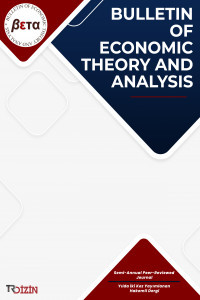Petrol Fiyatları ve Döviz Kuru Arasındaki İlişkiye Asimetrik Bakış Açısı: Türkiye Örneği
Petrol fiyatları uluslararası piyasalarda hem anahtar fiyatlardan biri olarak hem de petrol dışındaki diğer enerji kaynakları için bir gösterge fiyat olarak kullanılmaktadır. Özellikle de Türkiye gibi gelişmekte olan, petrol ihracatçısı ülkelerde, bu önemli girdinin döviz kuru ile ilişkisi her dönem ilgi çekici bir araştırma konusu olmuştur.Bu çalışmada Türkiye’de petrol fiyatları ve nominal döviz kuru arasındaki ilişki 2 Ocak 2002-12 Ekim 2021 dönemi için, günlük veri seti kullanılarak (toplam 5161 gözlem) simetrik ve asimetrik nedensellik testleri ile incelenmektedir. Yapılan analizlerden elde edilen bulgular simetrik analizde değişkenler arasında karşılıklı bir nedensellik ilişkisinin varlığına işaret etmektedir. Asimetrik analizde ise hem pozitif hem de negatif bileşenlerde petrol fiyatlarından döviz kuruna doğru bir nedensellik olduğuna işaret etmektedir. Diğer taraftan, pozitif bileşenlerde döviz kurundan petrol fiyatlarına doğru nedensellik sadece istatistiksel olarak %10 anlamlılık düzeyinde söz konusu iken, negatif bileşenlerde ise döviz kurundan petrol fiyatlarına doğru istatistiksel olarak %5 anlamlılık düzeyinde nedensellik ilişkisi olduğu görülmektedir.
Anahtar Kelimeler:
Petrol Fiyatları, Nominal Döviz Kuru, Nedensellik Analizi
Asymmetric Approach to the Relation Between Oil Prices and Exchange Rate: The Case of Turkey
Oil prices are used in international markets both as one of the key prices and as an indicator price for other energy sources other than oil. Especially in developing oil exporter countries such as Turkey, the relationship of this important input to the exchange rate has been an interesting research topic every period.In this study the relationship between oil prices and nominal exchange rate in Turkey is examined using a daily data set (total 5161 observations) using symmetric and asymmetric causality tests for the January 2, 2002 to October 12, 2021 period. The findings from the analyses indicate the existence of a mutual causality relationship between variables in symmetric analysis. In asymmetric analysis, it points out that there is a causality between oil prices and the exchange rate in both positive and negative components. On the other hand, causality from the exchange rate to oil prices in positive components is only statistically significant at the 10% significance level, while in negative components there is a causality relationship at the 5% significance level statistically from the exchange rate to oil prices.
Keywords:
Oil Prices, Nominal Exchange Rate, Causality Analysis,
___
- Adıgüzel, U., Kayhan, S., ve Bayat, T. (2016). Petrol fiyatları ve döviz kuru arasındaki ilişkinin ampirik analizi: asimetrik nedensellik analizi. Cumhuriyet Üniversitesi İktisadi ve İdari Bilimler Dergisi, 17(2), 241-252.
- Altıntaş, H. (2013). Türkiye’de petrol fiyatları, ihracat ve reel döviz kuru ilişkisi: ARDL sınır testi yaklaşımı ve dinamik nedensellik analizi. Uluslararası Yönetim İktisat ve İşletme Dergisi, 9(19), 1-30.
- Dücan, E., ve Şentürk, M. Döviz kuru ve petrol fiyatı ilişkisi: Küresel Finans Krizi Sonrası Deneyimler. Dünden Bugüne Ekonomi Yazıları, 53.
- Hacker, R. S., & Hatemi-J, A. (2006). Tests for causality between integrated variables using asymptotic and bootstrap distributions: theory and application. Applied Economics, 38(13), 1489-1500.
- Hatemi-j, A. (2012). Asymmetric causality tests with an application. Empirical Economics, 43(1), 447-456.
- Yardımcıoğlu, F., ve Beşel, F. (2013). İşsizlik--petrol fiyatları ilişkisi: yapısal kırılmalar altında türkiye örneği (1980-2012). Electronic Turkish Studies, 8(8).
- Yaylalı, M., ve Lebe, F. (2012). İthal ham petrol fiyatlarının türkiye’deki makroekonomik aktiviteler üzerindeki etkisi. Marmara Üniversitesi İktisadi ve İdari Bilimler Dergisi, 32(1), 43-68.
- Yayın Aralığı: Yılda 2 Sayı
- Başlangıç: 2016
- Yayıncı: Mehmet SONGUR
Sayıdaki Diğer Makaleler
Denetimin Değişen Yüzü; Geleceğin Denetçisi
Kadir GÖKOĞLAN, İbrahim ÇEMBERLİTAŞ
Yeni Bir Kurum Olarak Strateji ve Bütçe Başkanlığı: Kısa Bir Değerlendirme
Döviz Kuru ile Sanayi Üretimi Arasındaki Nedensellik İlişkisi Üzerine Bir Uygulama (2005-2019)
Sevgi ÇALIŞCİ, Pelin KARATAY GÖGÜL
Petrol Fiyatları ve Döviz Kuru Arasındaki İlişkiye Asimetrik Bakış Açısı: Türkiye Örneği
An Analysis of the Relationship between Inflation and Gold Prices: Evidence from Turkey
